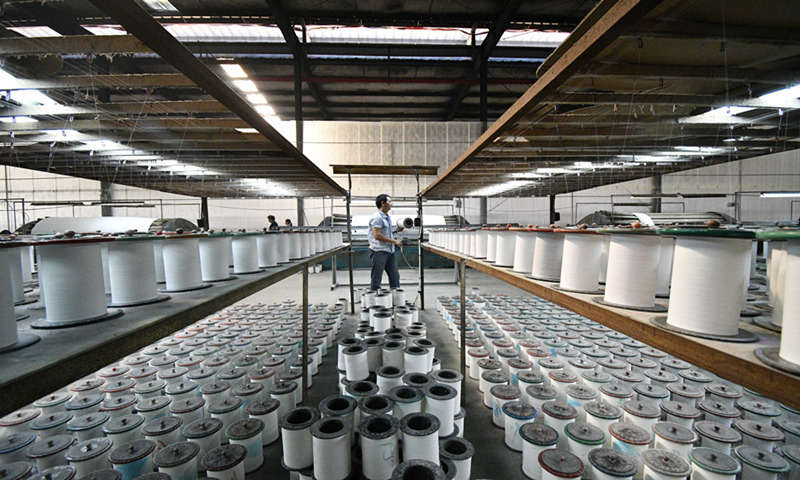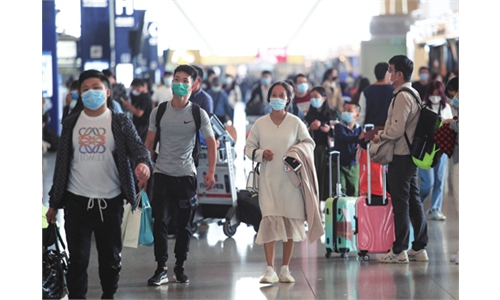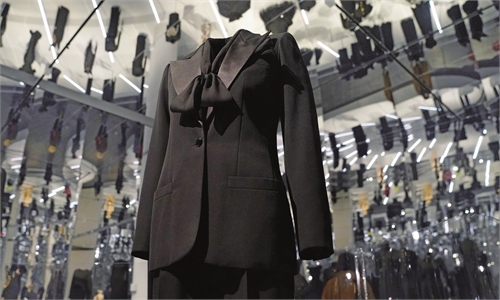
Textile workers manufacturing for export orders at the Jinxi industrial park in Fuzhou, East China's Jiangxi Province on October 16, 2020 Photo: VCG
The coronavirus pandemic increased unemployment in China, especially among the low-skilled and most vulnerable, but the blue-collar labor force is beginning to see a rebound in job opportunities as China's manufacturing continues to recover.
Henglin Home Furnishings, a furniture exporter based in East China's Zhejiang Province, has been experiencing the sweet pain of having too many orders and too few hands. The company has raised salaries by 30 percent to attract more applications, its manager surnamed Quan told the Global Times.
Starting salaries for workers on the assembly line have been raised to 8,000 ($1,192) to 10,000 yuan per month, a decent amount anywhere and far exceeding the average salary of university graduates at around 5,290 yuan nationwide, calculated in September by zhilianzhaopin.com, one of the biggest hiring platforms in China.
"At first we wanted to hire experienced workers, but now we are accepting more apprentices as well to fill the gap," Quan said, "We've been having a shortage of hands since the second quarter, when orders started to surge."
Manufacturing and export sectors often move in tandem with the employment situation. Since the second quarter, China's manufacturing activity has been rebounding since hitting a low point in February. In September, the manufacturing PMI rose to 51.5, and exports climbed by 9.9 percent.
The rising job opportunities are in sharp contrast to earlier this year, when the COVID-19 outbreak paralyzed the economy and heighted unemployment. According to a survey conducted by Peking University and zhilianzhaopin.com, job openings for the first two months of this year were down 30 percent year-on-year. In the official data released by the National Bureau of Statistics, unemployment rate in February registered 6.2 percent, a rare sharp rise from 5.3 percent in the same period last year.
For Quan, his company currently has around 200 vacancies to fill. Hiring teams from the company have travelled as far as Southwest China's Yunnan Province and Northern China's Inner Mongolia to recruit new workers, whereas in the past most employees were local or from nearby cities.
He said that the recent soaring demand is from the international market as well as the domestic ones. In September, China's new export orders recorded the steepest growth since the start of 2011.
"Our business has expanded by more than half because people are spending more time at home in the US and Europe, and they are ordering more home office furniture," Quan said.
The coming Double Eleven shopping festival has also given the manufacturing sector an extra boost. According to a manager surnamed Bao from Longda Printing Textile Company, based in East China's Jiangsu Province, this year's Double Eleven has been especially rushed, putting more weight on their recruiting process.
"Many companies on Taobao and Tmall are using livestreaming for promotion, so the orders only come at the last minute. Usually we have at least a month for production; now we need to find people to finish the order in only a week."
But manufacturers also worry that the rapidly surging demand for labor might be exposing a murky side to the picture. For Bao, whose 30-employee company is relatively small, the sudden increase in new orders is creating vicious competition among employers, and might lead to overstaffing when the hiring frenzy is over.
"One of our competitors is offering 500 yuan per day for general workers," Bao said. "But if I hire too many people at a high price right now, how am I supposed to pay them when production resumes in other countries and our orders are down?"
Li Weiyuan, general manager of the Anji Kabel Furniture Company, told the Global Times that in Anji, Zhejiang, also known as the world's chair factory, most furniture companies predict that the surging trend is not likely to last beyond May or June next year.
"The production period for each order is around three months, and given our scale of production, we are worried that once foreign factories resume operation, it will cause a large fluctuation in our overseas orders, leading to overstock for us manufacturers."




